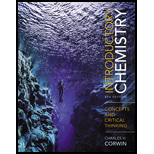
(a)
Interpretation:
The direction of the equilibrium on decreasing concentration of
Concept introduction:
Equilibrium is the state where the concentration of the reactant is equal to the concentration of the product. According to Le Chatelier’s Principle, it states that the equilibrium shifts in such a way or a direction that it can reduce the effect of change.
(b)
Interpretation:
The effect of decreasing concentration of hydrogen ion is to be stated.
Concept introduction:
Equilibrium is the state where the concentration of the reactant is equal to the concentration of the product. According to Le Chatelier’s Principle, it states that the equilibrium shifts in such a way or a direction that it can reduce the effect of change.
(c)
Interpretation:
The direction of the equilibrium on increasing concentration of
Concept introduction:
Equilibrium is the state where the concentration of the reactant is equal to the concentration of the product. According to Le Chatelier’s Principle, it states that the equilibrium shifts in such a way or a direction that it can reduce the effect of change.
(d)
Interpretation:
The direction of the equilibrium on increasing concentration of
Concept introduction:
Equilibrium is the state where the concentration of the reactant is equal to the concentration of the product. According to Le Chatelier’s Principle, it states that the equilibrium shifts in such a way or a direction that it can reduce the effect of change.
(e)
Interpretation:
The direction of the equilibrium on adding solid
Concept introduction:
Equilibrium is the state where the concentration of the reactant is equal to the concentration of the product. According to Le Chatelier’s Principle, it states that the equilibrium shifts in such a way or a direction that it can reduce the effect of change.
(f)
Interpretation:
The direction of the equilibrium on adding solid
Concept introduction:
Equilibrium is the state where the concentration of the reactant is equal to the concentration of the product. According to Le Chatelier’s Principle, it states that the equilibrium shifts in such a way or a direction that it can reduce the effect of change.
(g)
Interpretation:
The direction of the equilibrium on adding solid
Concept introduction:
Equilibrium is the state where the concentration of the reactant is equal to the concentration of the product. According to Le Chatelier’s Principle, it states that the equilibrium shifts in such a way or a direction that it can reduce the effect of change.
(h)
Interpretation:
The direction of the equilibrium on increasing
Concept introduction:
Equilibrium is the state where the concentration of the reactant is equal to the concentration of the product. According to Le Chatelier’s Principle, it states that the equilibrium shifts in such a way or a direction that it can reduce the effect of change.
Want to see the full answer?
Check out a sample textbook solution
Chapter 16 Solutions
Introductory Chemistry: Concepts and Critical Thinking Plus MasteringChemistry with eText -- Access Card Package
- . What does it mean to say that a state of chemical or physical equilibrium is dynamic?arrow_forwardShow that the complete chemical equation, the total ionic equation, and the net ionic equation for the reaction represented by the equation KI(aq)+I2(aq)KI3(aq) give the same expression for the reaction quotient. KI3 is composed of the ions K+ and I3-.arrow_forwardDescribe a nonchemical system that is not in equilibrium, and explain why equilibrium has not been achieved.arrow_forward
- At a temperature of 60 C, the vapor pressure of water is 0.196 atm. What is the value of the equilibrium constant KP for the transformation at 60 C? H2O(l)H2O(g)arrow_forwardIf this reaction releases heat, what direction will the equilibrium shift when: 1. the amount of N_2N2 is decreased? 2. the heat of the system is increased? 3. an inert gas with pressure 3.00 atm is placed in the system? 4. the volume of the system is reduced? 5. a catalyst in the reaction is placed?arrow_forwardWhat is the value of Kp at 675.00 K?arrow_forward
 Chemistry by OpenStax (2015-05-04)ChemistryISBN:9781938168390Author:Klaus Theopold, Richard H Langley, Paul Flowers, William R. Robinson, Mark BlaserPublisher:OpenStax
Chemistry by OpenStax (2015-05-04)ChemistryISBN:9781938168390Author:Klaus Theopold, Richard H Langley, Paul Flowers, William R. Robinson, Mark BlaserPublisher:OpenStax Chemistry: Principles and ReactionsChemistryISBN:9781305079373Author:William L. Masterton, Cecile N. HurleyPublisher:Cengage Learning
Chemistry: Principles and ReactionsChemistryISBN:9781305079373Author:William L. Masterton, Cecile N. HurleyPublisher:Cengage Learning Physical ChemistryChemistryISBN:9781133958437Author:Ball, David W. (david Warren), BAER, TomasPublisher:Wadsworth Cengage Learning,
Physical ChemistryChemistryISBN:9781133958437Author:Ball, David W. (david Warren), BAER, TomasPublisher:Wadsworth Cengage Learning, Chemistry: Principles and PracticeChemistryISBN:9780534420123Author:Daniel L. Reger, Scott R. Goode, David W. Ball, Edward MercerPublisher:Cengage Learning
Chemistry: Principles and PracticeChemistryISBN:9780534420123Author:Daniel L. Reger, Scott R. Goode, David W. Ball, Edward MercerPublisher:Cengage Learning Introductory Chemistry: A FoundationChemistryISBN:9781337399425Author:Steven S. Zumdahl, Donald J. DeCostePublisher:Cengage Learning
Introductory Chemistry: A FoundationChemistryISBN:9781337399425Author:Steven S. Zumdahl, Donald J. DeCostePublisher:Cengage Learning




